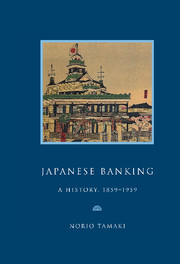Book contents
- Frontmatter
- Contents
- Preface
- Genealogy of leading Japanese banks, 1859–1959
- List of abbreviations
- Map
- Part I A bankrupt Shogunate, 1859–1868
- Part II The Meiji Restoration: monetary confusion and banking experiments, 1868–1881
- Part III Matsukata, the wizard of Japanese banking, 1881–1897; the Yokohama Specie Bank (1880) and the Bank of Japan (1882)
- Historical background
- 9 The Bank of Japan, or Nichigin, 1881–1897
- 10 The Yokohama Specie Bank, or Shokin, 1882–1897
- 11 Consolidation and expansion, 1883–1897
- 12 The adoption of the gold standard, 1893–1897
- Part IV The Japanese on the London money market, 1897–1911
- Part V War, the Japanese boom years, 1911–1919
- Part VI Crisis and the road to war, 1919–1937
- Part VII Complete commitment, struggle and defeat, 1937–1945
- Part VIII American ‘democratisation’ and the search for growth, 1945–1959
- An extraordinary century, 1859–1959
- Appendices
- Notes
- Bibliography
- Index
9 - The Bank of Japan, or Nichigin, 1881–1897
Published online by Cambridge University Press: 03 February 2010
- Frontmatter
- Contents
- Preface
- Genealogy of leading Japanese banks, 1859–1959
- List of abbreviations
- Map
- Part I A bankrupt Shogunate, 1859–1868
- Part II The Meiji Restoration: monetary confusion and banking experiments, 1868–1881
- Part III Matsukata, the wizard of Japanese banking, 1881–1897; the Yokohama Specie Bank (1880) and the Bank of Japan (1882)
- Historical background
- 9 The Bank of Japan, or Nichigin, 1881–1897
- 10 The Yokohama Specie Bank, or Shokin, 1882–1897
- 11 Consolidation and expansion, 1883–1897
- 12 The adoption of the gold standard, 1893–1897
- Part IV The Japanese on the London money market, 1897–1911
- Part V War, the Japanese boom years, 1911–1919
- Part VI Crisis and the road to war, 1919–1937
- Part VII Complete commitment, struggle and defeat, 1937–1945
- Part VIII American ‘democratisation’ and the search for growth, 1945–1959
- An extraordinary century, 1859–1959
- Appendices
- Notes
- Bibliography
- Index
Summary
The chronic specie shortage, 1881–1885
On his appointment as Finance Minister, in October 1881, Masayoshi Matsukata addressed his staff as follows:
The most urgent financial measure to be taken is to relieve the country of the evils of an inconvertible currency … I have a new series of policies which will undoubtedly bring results. It is proposed to carry out these ideas regardless of public opposition.
Although the unrestrained issue of inconvertible notes, from both government and national banks, had stopped shortly before Matsukata's appointment, the total amount in circulation was still ¥153.3 million, which was 93 per cent of the amount in 1878, the worst year during the Meiji inflation. Matsukata's idea was simply ‘to try hard to redeem as much as possible of the excess of notes on the one hand and to accumulate as much specie as possible which would be applied for the reserve of conversion on the other hand’. In spite of his confidence the amount of specie was at that time standing as low as ¥8.7 million, only 5 per cent of the total inconvertible note circulation and 16 per cent of the reserve fund specially set up for the redemption of government notes. It was, therefore, understandable that Sir Henry Parkes, British minister, should express serious doubts. Nevertheless, Matsukata persisted.
The first job was not difficult. Matsukata immediately on his appointment decided to abolish the government notes in reserve, which were available for temporary expenditures to take account of any time lag between tax collection and its distribution among the ministries. Matsukata totally prohibited these casual expenditures.
- Type
- Chapter
- Information
- Japanese BankingA History, 1859–1959, pp. 58 - 68Publisher: Cambridge University PressPrint publication year: 1995



